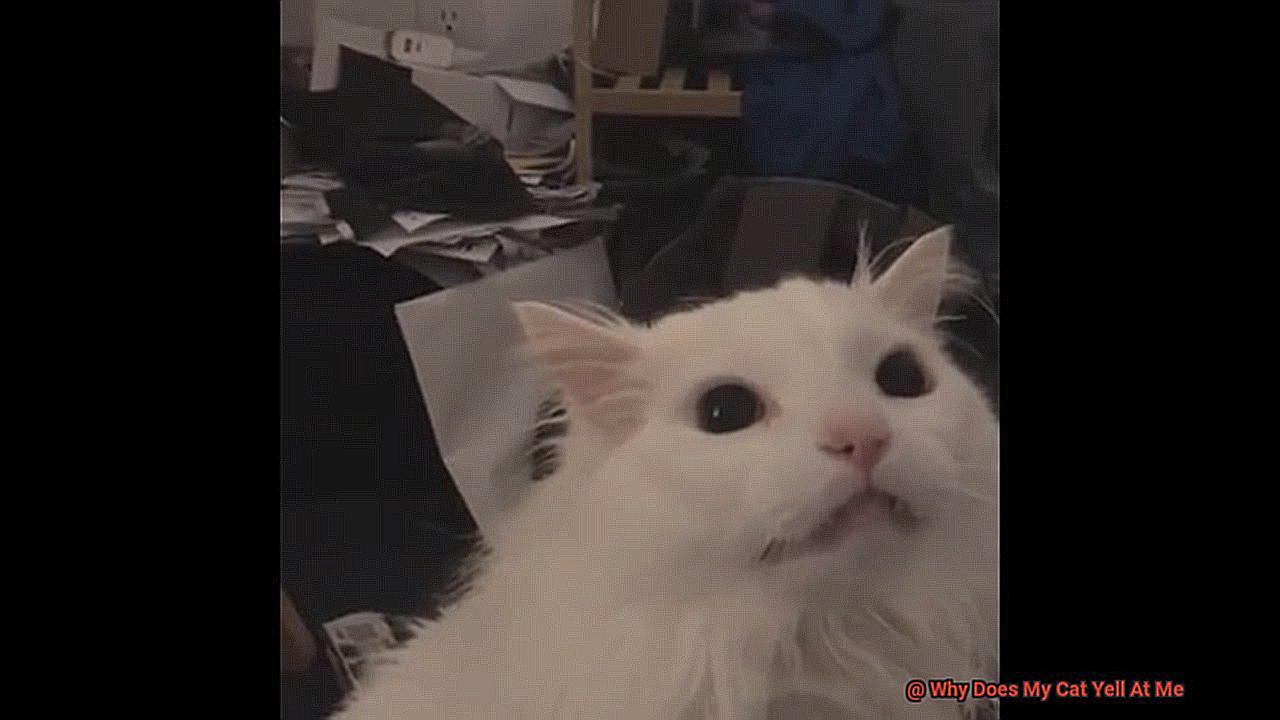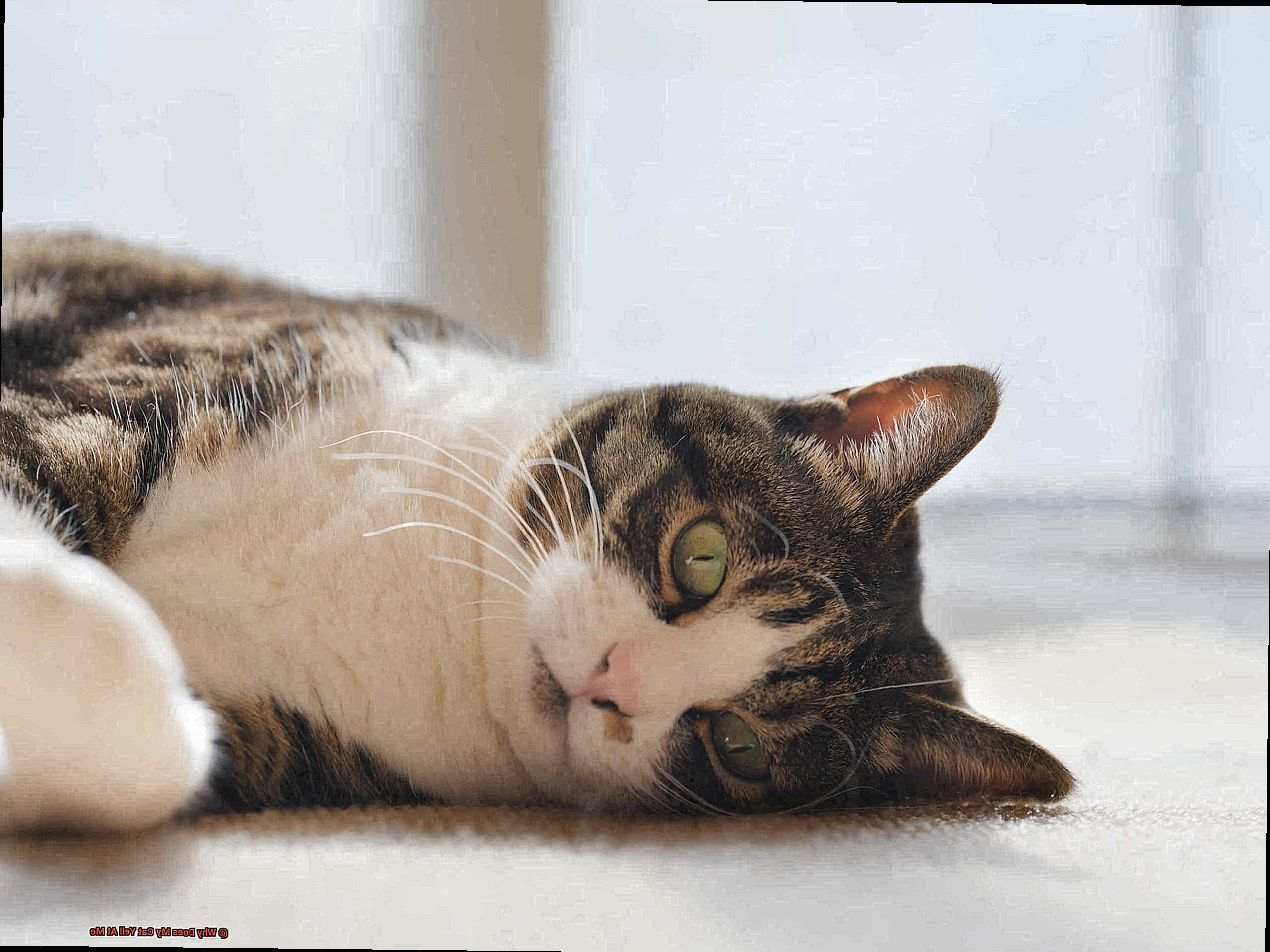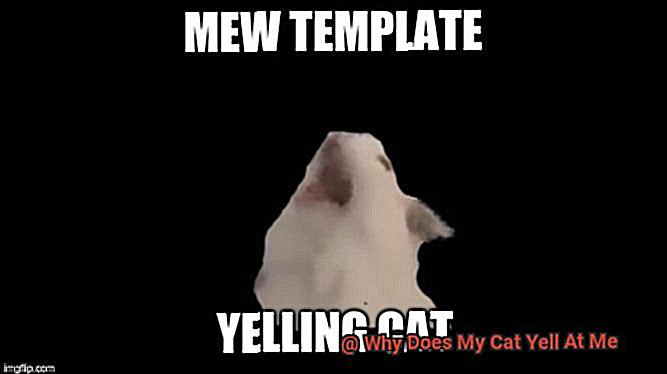As a cat owner, you’re probably well aware of how vocal feline friends can be.
They meow, chirrup, purr – and sometimes, they yell. Yes, you read that right: cats are capable of yelling at their owners.
But what does it mean when your cat starts hollering? Is it a sign of aggression or a cry for attention?
Fear not – we’ve got the answers. It’s important to remember that cats use vocalization as a means of communication with their humans.

Yowling, meowing, and hissing are all ways in which they express their emotions, including anxiety, stress, and anger. But when it comes to yelling, things can get pretty intense.
It’s often loud and overwhelming for pet parents. So why do cats yell?
One common reason is simply to get their owner’s attention. Maybe they’re hungry, need to use the litter box, or want to play.

Other times, they’ll yell as a way to communicate their displeasure – for example, if their litter box isn’t clean or if they don’t like their food.
If you’ve ever found yourself wondering why your cat is yelling at you, don’t worry – it’s not because they don’t love you or because you’re doing something wrong.
Understanding Cat Yelling
Understanding why your cat is yelling is crucial in addressing their behavior and maintaining a healthy relationship with your feline friend. Cats can yell for various reasons, including hunger, stress, discomfort, or even boredom.
To determine the cause of their vocalizations, pay attention to their body language and the context in which they are meowing or yelling. One of the most common reasons for cats to yell is hunger.
If your cat’s feeding time has passed, they may start meowing persistently until they get food. To avoid this behavior, make sure your cat is getting enough food and stick to a consistent feeding schedule.
If your cat is experiencing discomfort or pain, such as digestive issues or dental problems, they may communicate their discomfort through vocalization. In such cases, it’s crucial to take them to the vet for proper diagnosis and treatment.
Stress and anxiety can also cause cats to yell. Changes in their environment, like moving to a new home or the presence of other pets, may cause them to feel stressed and anxious.
Providing them with a safe and comfortable space, regular exercise, and playtime can help alleviate these feelings. Boredom could also be another reason for your cat’s yelling behavior.
If they are not getting enough mental stimulation, they may express their frustration by meowing loudly. Providing interactive toys, scratching posts, or even adopting another pet can keep them entertained.
To address your cat’s yelling behavior effectively, you must identify the root cause of their vocalizations.
Cats Yell When Hungry

Cats are creatures of habit and tend to become vocal at specific times of the day when they know they will be fed. So, if your cat is meowing loudly or following you around the house, chances are they’re trying to tell you that they’re hungry and want to be fed.
It’s important to understand that cats have different feeding requirements based on their age, activity level, and health status. For instance, kittens and senior cats may require more frequent feedings than adult cats.
And cats with certain health conditions may need specialized diets. So, it’s vital to understand your cat’s feeding requirements and provide them with the appropriate amount of food.
However, excessive or odd-time yelling may be a sign of an underlying health issue. Cats with hyperthyroidism or diabetes may become vocal when they’re hungry or thirsty as their bodies crave nutrients.
Hence, it’s crucial to take your cat to the vet for a check-up if you notice any changes in their behavior or eating habits. In conclusion, cats yelling when hungry is a natural behavior that owners should expect.
As responsible cat owners, we must pay attention to our furry friends’ body language and context to determine the cause and seek professional help if necessary.
Discomfort and Pain as Reasons for Yelling
Discomfort and pain may be the culprits behind this behavior.
Cats are known for being stoic creatures who mask their pain or discomfort well. However, sometimes their discomfort can manifest in the form of excessive meowing or yelling.
As responsible pet owners, it’s essential to take note of any changes in your cat’s behavior or routine. One of the most common causes of discomfort in cats is dental issues.
Cats can develop gum disease, tooth decay, and other dental problems that can be painful and make it difficult for them to eat or groom themselves. If your cat is yelling while eating or avoiding certain foods altogether, it could be a sign of dental issues.
Another potential cause of discomfort in cats is arthritis. Arthritis is a common condition in older cats that can cause joint pain and stiffness.
Your cat may yell while jumping up or down from furniture or while using the litter box if they are experiencing arthritis pain.
If you suspect your cat is experiencing discomfort or pain, it’s crucial to take them to the veterinarian for an examination.
Stress and Anxiety in Cats
Stress and anxiety are common factors that can lead to excessive vocalization in cats.

These emotions can be triggered by changes in their environment, routine, or relationships, causing them to express their frustration through yelling. If you’ve recently introduced a new family member or moved to a new home, your cat may feel overwhelmed and anxious.

To help ease their transition, provide them with ample hiding spots and familiar scents to make them feel comfortable. A consistent routine for feeding, playtime, and grooming is also essential in minimizing disruptions that may trigger stress.
Loud noises and the presence of other animals can also cause stress and anxiety in cats. As territorial creatures, they may feel threatened by unfamiliar animals in their space.
If this is the case, try to limit their interactions with other animals and provide them with a safe space they can retreat to when feeling uncomfortable. Owners should aim to create a calm and comfortable environment for their pets.
This can be achieved by providing quiet spaces and familiar scents. Additionally, owners should establish a consistent routine for feeding, playtime, and grooming to minimize disruptions that may trigger stress.
If these measures do not alleviate the cat’s vocalization behavior, owners should consider consulting with a veterinarian or animal behaviorist for further guidance. They may recommend behavioral therapy or medication to help manage the cat’s stress and anxiety levels.
Boredom Leads to Yelling
Cats are intelligent creatures that require stimulation to stay engaged and happy.
When they don’t get enough exercise or mental stimulation, they become restless and resort to excessive meowing or yelling. As a responsible pet owner, it’s essential to keep your cat entertained and mentally stimulated.
One way to prevent boredom is to provide them with toys, scratching posts, and interactive games that stimulate their minds and bodies. These activities will keep your cat engaged and entertained for hours on end.
Creating a schedule of playtime and exercise can also help keep your cat active and prevent boredom-related behaviors. Simple activities such as hiding treats around the house or setting up a cardboard maze can provide mental stimulation for cats.
It’s important to note that excessive yelling may also be a sign of an underlying health issue such as hyperthyroidism or anxiety. Therefore, it’s crucial to monitor your cat’s behavior and seek veterinary attention if necessary.
In conclusion, preventing boredom is the key to preventing excessive yelling in cats. By providing mental and physical stimulation through toys, games, and exercise, you can help keep your cat engaged and happy.
Remember to always monitor your cat’s behavior and seek veterinary attention if necessary.
Pay Attention to Body Language and Vocalizations
From meows to purrs and hisses, cats use their vocalizations to communicate their needs and emotions.
But did you know that deciphering your cat’s body language is just as important? By paying attention to both their vocalizations and body language, you can better understand what your cat is trying to tell you.
Meows are the most common way that cats communicate with their humans. They can signify anything from hunger and thirst to a desire for attention or playtime.
However, the tone and volume of a meow can also convey different messages. A low-pitched meow may indicate that your cat is unhappy or in distress, while a high-pitched meow could suggest excitement or playfulness.
Purring is another vocalization that cats use frequently. While it’s typically associated with contentment, cats may also purr when they’re in pain or feeling stressed out.
To understand what your cat is trying to tell you through their purring, pay attention to their body language. If they’re relaxed and snuggled up next to you, it’s likely a sign that they’re happy.
On the flip side, if your cat is hissing or growling at you, it’s important to give them space and not approach them until they’ve calmed down. These aggressive vocalizations are warning signs that your cat is feeling threatened or scared.
By respecting their signals and giving them room to breathe, you can build trust with your furry friend and create a safe space for them to express themselves. But it’s not just vocalizations that matter – body language is key too.
A relaxed cat will hold their ears forward and their tail loosely behind them. If they’re anxious or frightened, however, they may flatten their ears against their head and tuck their tail between their legs.
By paying attention to both vocalizations and body language, you can deepen your understanding of your cat’s needs and emotions. This will help you provide them with the care and attention they require to stay healthy and happy.
2w00lGT_m4w” >
Avoiding Hunger-Related Yelling
There are some simple strategies you can implement to prevent hunger-related yelling.
Firstly, establishing a feeding routine is key. Cats thrive on routine and predictability, so feeding your cat at the same time every day will help them understand when to expect their meals.
This will also prevent them from meowing persistently for food outside of their designated meal times. In addition to setting a routine, it’s important to provide your cat with appropriate amounts of food tailored to their size and age.
Overfeeding can lead to obesity and health problems, while underfeeding can cause hunger-related behavior. Consulting with your veterinarian will help you determine the ideal amount of food for your cat’s specific needs.
If your cat still meows for food after implementing these strategies, consider using puzzle feeders or interactive toys to make mealtime more engaging. These activities not only provide mental stimulation and physical exercise but also satisfy your cat’s hunger.
It’s crucial to note that excessive hunger-related yelling could be a sign of an underlying medical condition. Therefore, if you’ve tried all of these strategies and your cat’s behavior persists, consult with your veterinarian as soon as possible to rule out any health issues.
By establishing a feeding routine, providing appropriate amounts of food, and incorporating interactive activities into mealtime, you can prevent hunger-related yelling in your beloved feline friend.
Also Read: Why Does My Cat Meow When I Cough?
Conclusion
In conclusion, our feline friends are not shy about expressing themselves through various vocalizations, including meows, purrs, hisses, and yes, even yells.
However, yelling can be a sign of underlying issues such as hunger, discomfort or pain, stress and anxiety, or boredom. As responsible pet owners, it’s crucial to pay attention to our cats’ body language and the context in which they are yelling to determine the root cause.
Providing them with adequate food and mental stimulation through toys and exercise can help alleviate their feelings of frustration or boredom. Moreover, creating a safe and comfortable space for your cat when they’re anxious or stressed out is equally important.
Establishing a feeding routine tailored to your cat’s specific needs while providing appropriate amounts of food will also go a long way in curbing excessive yelling. If you’ve tried all these strategies but your cat’s behavior persists, consulting with a veterinarian or animal behaviorist is recommended.







